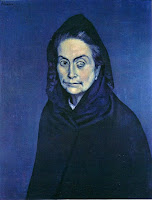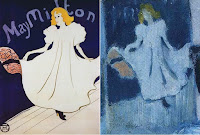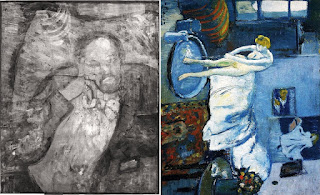 |
| The Blue Room (1901) by Pablo Picasso |
The Blue Room
The Blue Room (La Chambre Bleue, Le Tub) is an oil painting on canvas, created in Pablo Picasso’s Blue Period by the artist in 1901. As one of the Picasso’s monochromatic paintings made in early 20th century, The Blue Room has the feature of including the shades of blue color greatly likewise The Old Guitarist has. The original canvas is exhibited in the Phillip’s Collection Washington D.C. In 2014, with the support of National Gallery of Art and Winterthur Museum, scientists and art experts from Cornell University in New York and the Phillips Collection in Washington D.C., have done a research by using scientific methods to discover the painting underneath The Blue Room. As one of the Picasso’s first masterpieces, The Blue Room reveals an opportunity to track the facts about Picasso's life including the information from his economic state to the avant garde art movements which he highly contributed.
The Blue Room in Picasso’s Blue Period Art
 |
| The Death of Casagemas (1901) by Pablo Picasso |
 |
| Celestina (1904) by Pablo Picasso |
Inspiration Source of the Blue Room
 |
| The Boulevard Montmartre at Night (1897) by Camille Pissarro |
 |
| Boulevard de Clichy (1881-1973) by Pablo Picasso |
 |
| May Milton (1895) by Henri de Toulouse-Lautrec |
Hidden Image Beneath the Blue Room
 |
| The Blue Room X ray Image |
Mystery Man Beneath the Blue Room
 |
| Ambroise Vollard in front of The Evocation (The Burial of Casagemas, 1901) by Pablo Picasso |
 |
| Portrait of Ambroise Vollard (1910) by Pablo Picasso |
The Blue Room Technical Analysis
 |
| Picasso's Color Palette for The Blue Room |
 |
| Guernica (1937) by Pablo Picasso |
Hidden Images in Picasso Paintings
 |
| Woman Ironing (1904) by Pablo Picasso - Left
Renovated X ray Image - Right
|
 |
| The Old Guitarist (1903-1904) by Pablo Picasso |
 |
| Pablo Picasso Self-Portrait (1901) |
The Blue Room in Seoul South Korea Exhibition
 |
| Daejeon Museum of Art, Seoul South Korea |
The Blue Room Value and Sizes
 |
| Nude, Green Leaves and Bust (1932) by Pablo Picasso |
 |
| Women of Algiers (1955) by Pablo Picasso |
The Blue Room by Pablo Picasso
 Reviewed by Articonog
on
March 26, 2020
Rating:
Reviewed by Articonog
on
March 26, 2020
Rating:
 Reviewed by Articonog
on
March 26, 2020
Rating:
Reviewed by Articonog
on
March 26, 2020
Rating:





Thank you for this informative and fascinating article.
ReplyDeleteThis was incredibly helpful. Thank you so much!
ReplyDelete